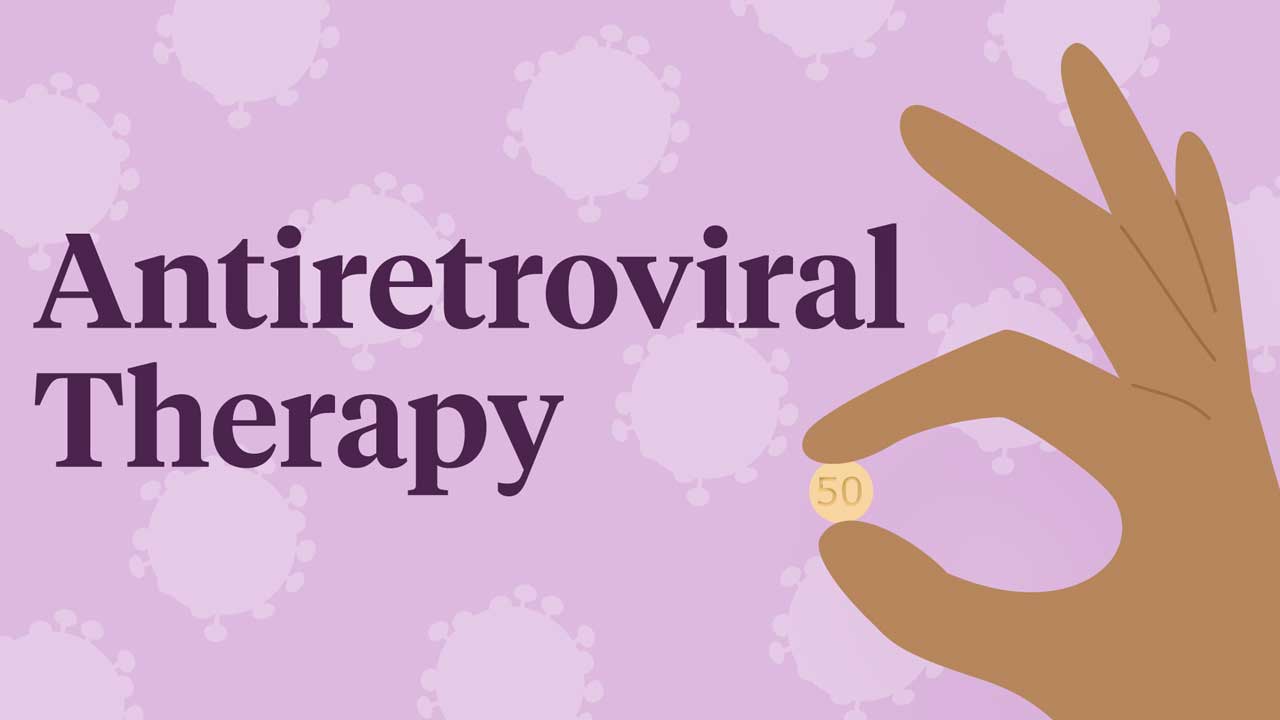The most effective treatment for HIV/AIDS is antiretroviral therapy (ART), which involves taking a combination of antiretroviral medicines to prevent HIV from multiplying (HIVinfo.nih.gov 2025).
The Human Immunodeficiency Virus (HIV) Life Cycle
In order to understand how antiretroviral treatment works, we first need to understand the life cycle of the human immunodeficiency virus (HIV).
HIV specifically targets and destroys CD4 cells (CD4 T lymphocytes), a type of white blood cell that is important for a well-functioning immune system. As more and more CD4 cells are destroyed by the virus, the immune system weakens (Montoya 2023).
Upon HIV entering the bloodstream, there are several steps to its life cycle:
- Binding: HIV attaches itself to the receptors of a CD4 cell in the immune system.
- Fusion: The HIV envelope and CD4 cell membrane fuse, allowing HIV to enter the CD4 cell.
- Reverse transcription: HIV genetic material (RNA) is converted into HIV DNA using the reverse transcriptase enzyme. The newly converted HIV DNA can enter the nucleus of the CD4 cell and combine with the cell’s DNA.
- Integration: HIV releases the integrase enzyme inside the CD4 cell nucleus. This enzyme allows HIV to integrate its own DNA into the CD4 cell’s DNA. The HIV infection is now established in the cell.
- Replication: The CD4 cell produces long chains of HIV proteins, which are the building blocks for more HIV.
- Assembly: HIV RNA and the new HIV proteins move to the surface of the CD4 cell. They assemble into non-infectious, immature HIV.
- Budding: The immature HIV leaves the CD4 cell and releases an enzyme known as protease, which breaks up the long protein chains to form mature, infectious HIV. The mature HIV then attacks other cells, beginning the process again.
(HIVinfo.nih.gov 2025b)
Antiretroviral Therapy

The aim of antiretroviral therapy is to stop HIV from progressing to acquired immune deficiency syndrome (AIDS) by stopping the HIV life cycle in its tracks and preventing the virus from multiplying (HIVinfo.nih.gov 2025b).
Antiretroviral therapy cannot cure HIV but provides the immune system with an opportunity to recover. It also aims to reduce the viral load in the body to an undetectable level, reducing the risk of transmission to others (HIVinfo.nih.gov 2025a).
ART medicines are categorised into several drug classes designed to block different stages of the HIV life cycle. Generally, a person undergoing ART will take medicines from at least two different drug classes in order to obstruct the HIV life cycle at multiple stages (HIVinfo.nih.gov 2025b).
There are six classes of antiretroviral medicines used in Australia. These are:
- Nucleoside and nucleotide reverse transcriptase inhibitors (NRTIs)
- Non-nucleoside reverse transcriptase inhibitors (NNRTIs)
- Protease inhibitors (PIs)
- Integrase strand transfer inhibitors (INSTIs)
- Entry inhibitors: Fusion inhibitors
- Attachment inhibitors: CCR5 inhibitors.
(Healthdirect 2024)
In Australia, recommended practice is to initially start patients on a regimen of two NRTIs and one INSTI (ASHM 2024a).
While ART has demonstrated its effectiveness, it is important to note that there is potential for adverse reactions or drug-to-drug interactions to occur (ASHM 2023).
Barriers to Antiretroviral Therapy
HIV has a rapid rate of genomic evolution due to several factors:
- Rapid rate of viral production
- Rapid turnover of productively infected cells
- The reverse transcriptase enzyme being prone to errors.
(ASHM 2024b)
This rapid genomic evolution allows new strains and mutations of HIV to arise, some of which are resistant to antiretroviral therapy (ASHM 2024b).
Another identified issue is that in some cases, HIV viral load is detectable in semen despite being undetectable in the blood due to long-term ART. This suggests the presence of a persistent HIV reservoir in the male genital tract (Kariuki et al. 2020).
As with any treatment regimen, there are patient-related factors that may increase the risk of adverse drug reactions to ART. These include:
- Other medicines being taken
- Comorbidities including underlying liver disease, viral hepatitis infection, liver steatosis and renal dysfunction
- Psychiatric disorders (which may be exacerbated by certain antiretroviral medicines)
- Genetic predisposition to hypersensitivity to certain antiretroviral medicines
- Age (certain antiretroviral medicines are not recommended for children due to the potential for complications, or are not approved for children due to insufficient safety data).
(Clinicalinfo.HIV.gov 2023, 2024)
Compliance with treatment is essential and requires deep understanding and cooperation from patients and their family members. Consistent counselling and follow-ups are crucial in ensuring adherence.
Alternatives to Antiretroviral Therapy

Whilst there are no alternatives to ART currently available, there is ongoing research into new and different HIV treatments.
One such approach being studied is gene therapy, which involves modifying part of the body’s own genetic code in order to make CD4 cells resistant to HIV. It’s hoped that gene therapy may be a functional HIV cure that could negate the need for antiretroviral therapy (Alcorn 2020).
Another potential functional cure is bone marrow transplantation, however, there have only been two successful cases of this method to date (Warren 2019).
Attempts to develop a vaccine against HIV are currently in progress. While ART allows people with HIV to maintain viral suppression, lifelong adherence to the treatment is essential. The only perceived way to eradicate the virus completely is to remove its ability to be transmitted in the first place (HIV.gov 2024).
Conclusion
For the time being, it looks like antiretroviral therapy is the only effective treatment for HIV at our disposal.
As healthcare professionals, we need to continue to support our patients with HIV and ensure that compliance with treatment is maintained at all times.
Test Your Knowledge
Question 1 of 3
What is the primary goal of antiretroviral therapy in the treatment of HIV?
Topics
Further your knowledge
References
- Alcorn, K 2020, ‘Gene Therapy or Immunotherapy: Which Approach is More Likely to Deliver a Cure for HIV?’, NAM Aidsmap, 10 July, viewed 10 April 2025, https://www.aidsmap.com/news/jul-2020/gene-therapy-or-immunotherapy-which-approach-more-likely-deliver-cure-hiv
- Australasian Society for HIV, Viral Hepatitis and Sexual Health Medicine 2023, Adverse Effects of Antiretroviral Agents, ASHM, viewed 10 April 2025, https://hiv.guidelines.org.au/arv-adult/limitations/adverse-agents/
- Australasian Society for HIV, Viral Hepatitis and Sexual Health Medicine 2024a, Recommended Regimens for Treatment of HIV Infection, ASHM, viewed 10 April 2025, https://hivmanagement.ashm.org.au/antiretroviral-drugs/recommended-regimens-for-treatment-of-hiv-infection/
- Australasian Society for HIV, Viral Hepatitis and Sexual Health Medicine 2024b, Antiretroviral Drug Resistance Testing, ASHM, viewed 10 April 2025, https://hiv.guidelines.org.au/management/virological-tests/antiretroviral-drug-resistance-testing/
- Clinicalinfo.HIV.gov 2023, Limitations to Treatment Safety and Efficacy, National Institutes of Health, viewed 10 April 2025, https://clinicalinfo.hiv.gov/en/guidelines/hiv-clinical-guidelines-adult-and-adolescent-arv/adverse-effects-antiretroviral-agents
- Clinicalinfo.HIV.gov 2024, What Not to Start: Regimens Not Recommended for Use in Antiretroviral-Naive Children, National Institutes of Health, viewed 10 April 2025, https://clinicalinfo.hiv.gov/en/guidelines/pediatric-arv/regimens-not-recommended-initial-therapy-antiretroviral-naive-children
- Healthdirect 2024, Antiretroviral Treatment for HIV, Australian Government, viewed 10 April 2025, https://www.healthdirect.gov.au/antiretroviral-treatment-for-hiv
- HIV.gov 2024, HIV Vaccines, U.S. Department of Health & Human Services, viewed 10 April 2025, https://www.hiv.gov/hiv-basics/hiv-prevention/potential-future-options/hiv-vaccines
- HIVinfo.nih.gov 2025a, HIV Treatment: The Basics, National Institutes of Health, viewed 10 April 2025, https://hivinfo.nih.gov/understanding-hiv/fact-sheets/hiv-treatment-basics
- HIVinfo.nih.gov 2025b, The HIV Life Cycle, National Institutes of Health, viewed 10 April 2025, https://hivinfo.nih.gov/understanding-hiv/fact-sheets/hiv-life-cycle
- Kariuki, SM, Selhorst, P, Norman, J et al. 2020, ‘Detectable HIV-1 in Semen in Individuals With Very Low Blood Viral Loads’, Virology Journal, vol. 17, no. 29, viewed 10 April 2025, https://virologyj.biomedcentral.com/articles/10.1186/s12985-020-01300-6
- Montoya, S 2023, ‘What are the Effects of HIV on the Body?’, Medical News Today, 28 April, viewed 10 April 2025, https://www.medicalnewstoday.com/articles/316373
- Warren, M 2019, ‘Second Patient Free of HIV After Stem-Cell Therapy’, Nature, 5 March, viewed 10 April 2025, https://www.nature.com/articles/d41586-019-00798-3
 New
New 

